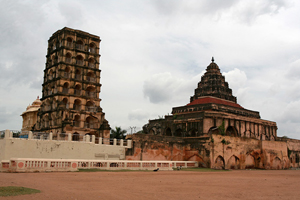 Thanjavur or Tanjore is world famous for its World Heritage Pragatheeswarar temple known by the locals as the Big Temple, is dedicated to Lord Siva. It was built by the great Chola King Raja Raja 1 (985 -1012 A.D). it is an outstanding exmple of Chola architecture. Recognizing its unique architectural excellence, UNESCO has declared it a World Heritage Monument. The speciality of this temple is that it has been sculptured completely with stones without having the Mountain around its surroundings.
Thanjavur or Tanjore is world famous for its World Heritage Pragatheeswarar temple known by the locals as the Big Temple, is dedicated to Lord Siva. It was built by the great Chola King Raja Raja 1 (985 -1012 A.D). it is an outstanding exmple of Chola architecture. Recognizing its unique architectural excellence, UNESCO has declared it a World Heritage Monument. The speciality of this temple is that it has been sculptured completely with stones without having the Mountain around its surroundings.
Raja Raja Chola, the greatest of the Chola emperors, ordered his men to build a big temple for Lord Pragatheeswarar. The chief sculptors and architects of this temple were Kunjaramallan and Raja Raja Perunthachan. This temple is a typical example for the Indian sculpture, its architectures and its greatness. The temple is covered by a moat on both sides. The Anaikut River flows on the other side. This temple has the tallest tower over the shrine. The height of the tower is 216 feet. The tomb is made of Bronze. The walls are painted with portrayals of the Chola and the Nayak Kings, the deeds that they did during their supremacy over Thanjavur. These paintings on the walls are compared with those in the Ajanta Cave Paintings. The gateway to the inner court yard is guarded by an elephant and one of the largest Nandhis in India measuring 6m long by 3m high, and fashioned from a single piece of rock The Massive Nandhi measures 25 tons weight. This is the second biggest Nandhi in India. In all, there are 250 lingams in the inner shrines along the outer walls. The frescoes adorning the walls and ceilings of the inner court yard have been dated to Chola times and were executed using techniques similar to those used in European frescoes work.
Unlike other temples the vimanam (the tower over the Sanctum) soars higher than the usual gopuram or portal tower. It soars to the height of 64.8m (208ft). It rises from a square base and shaped like a pyramid with 14 tiers, on th top of which is a higher monolithic cupola carved out from a 81.3 tonne block of granite. The wonder is that the shadow of the cupola never falls in the ground a testimony to the engineering skills of the Chola architecture. It was perched there from the village, ‘Saarappallam’ by rolling it along a ramp of earth six km along like the way in which the Egyptian pyramids were built. It is set on a spacious prakara of 240m by 125m. The Lingam in the sanctum is 3.70m high. It is the second largest in India, the first being the one at the Lepakshi temple in Andhra Pradesh.
An interesting story goes that an inclined plane was built so that an elephant could roll the block all the way to the top to install it. As an elephant cannot walk backwards another plane was built on the other side for the elephant to return to the ground. Whether, it happened or not, it makes a great story. It is indeed a great feat of engineering.
